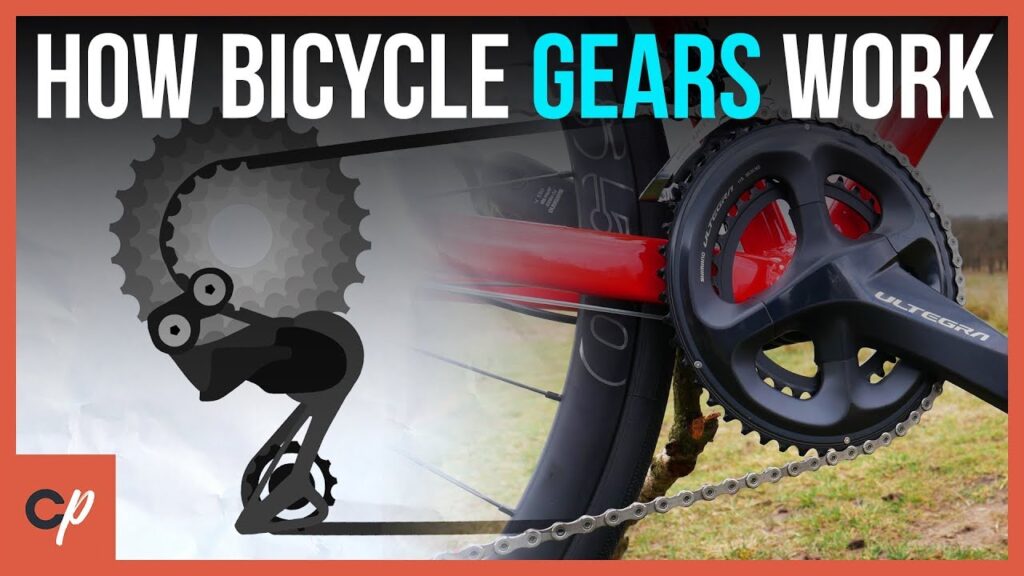Have you ever wondered how you glide so smoothly across various terrains on your bicycle? The secret lies in the gears.
How gears work on a bicycle can transform your cycling experience, making it more efficient and enjoyable. Imagine pedaling uphill without feeling like you’re climbing a mountain or cruising down a trail with the perfect speed. This knowledge empowers you to conquer any path with ease.
You’ll discover the magic behind bicycle gears, unveiling the mechanics that turn your cycling journey into a seamless adventure.
So, let’s dive in and unlock the secrets that will make every ride a breeze!
Basic Components of Bicycle Gears
Bicycle gears help riders tackle different terrains with ease. Understanding the basic components of bicycle gears is essential for smooth cycling. Each part plays a critical role in shifting and maintaining speed. Let’s explore these components in detail.
Derailleurs
Derailleurs guide the chain between gears. The front derailleur moves the chain across chainrings. The rear derailleur shifts the chain across cassette sprockets. Together, they ensure precise gear changes. They are essential for efficient riding. Regular maintenance keeps them functioning smoothly.
Shifters
Shifters are the control levers on the handlebars. Riders use them to change gears. They connect to the derailleurs through cables. A click of the shifter moves the chain. This allows for effortless gear transitions. They come in various styles, including trigger and twist shifters. Each offers a unique feel.
Chainrings And Cassettes
Chainrings are attached to the crankset. They determine the front gear ratios. Cassettes are located on the rear wheel. They consist of multiple sprockets. Together, they offer a wide range of gears. This provides flexibility for different riding conditions. Selecting the right combination improves efficiency and performance.
Types of Gear Systems
Have you ever wondered how bicycles manage to conquer steep hills and race down flat roads with ease? The secret lies in the gear systems. Understanding the different types of gear systems can transform your biking experience. Whether you’re a casual rider or a cycling enthusiast, knowing how gears work can enhance your ride, making it smoother and more efficient.
Traditional Gear Systems
Traditional gear systems are the most common and recognizable type. They’re usually found on road and mountain bikes. This system involves a series of sprockets and derailleurs. The rider manually shifts gears using levers attached to the handlebars.
As you pedal, the chain moves across the sprockets, altering the level of resistance. Have you ever noticed how shifting gears feels smoother on a well-maintained bike? That’s because the derailleur is perfectly aligned, ensuring seamless transitions.
Internal Hub Gears
Internal hub gears offer a different experience. They are contained within the rear hub of the bike. This means fewer visible components, making them ideal for urban bikes. The system provides a clean look and requires less maintenance.
They’re particularly useful when biking in wet or muddy conditions. You can shift gears even while stationary. Imagine stopping at a traffic light, and effortlessly shifting gears to prepare for a quick start. It’s a game-changer for city cyclists.
Electronic Gear Shifting
Electronic gear shifting is a modern marvel. It replaces traditional cables with electronic signals. With just a press of a button, gears shift smoothly and precisely. Professional cyclists often prefer this system for its speed and accuracy.
Have you ever experienced frustration during a race because of misaligned gears? Electronic systems eliminate this problem, ensuring consistent performance. It’s not just for pros; even recreational riders can benefit from its precision.
As you consider upgrading your bike or tuning your current setup, think about what type of gear system suits your style. Are you looking for simplicity, or do you crave cutting-edge technology? Your choice can greatly impact your cycling journey. What kind of adventures do you envision with the perfect gear system?
Functionality of Bicycle Gears
Whether you’re cruising down a hill or tackling a steep climb, bicycle gears are your secret weapon to maintain a smooth ride. They adjust your bike’s mechanical advantage, allowing you to pedal at a comfortable pace regardless of terrain. But how exactly do these gears work? Let’s dive into the functionality of bicycle gears and discover how they enhance your cycling experience.
Gear Ratio Explained
Imagine you’re facing a challenging uphill ride. You might wonder how to make pedaling easier without slowing down. That’s where gear ratios come into play. The gear ratio is the relationship between the front chainring and the rear sprocket.
Think of it as the difference between spinning your feet in circles or pushing hard against resistance. A lower gear ratio means you turn the pedals more times to rotate the wheel once, which is easier for uphill climbs. A higher ratio makes the wheel turn faster with fewer pedal strokes, perfect for speeding on flat surfaces.
Understanding gear ratios is like knowing the secret to adjusting your bike to your needs. You can choose the right gear to make your ride smooth and efficient.
How Shifting Works
Shifting gears on a bicycle is an art, and mastering it can transform your cycling experience. You shift gears using the shifters on your handlebars. These are connected to cables that move the derailleur, which guides the chain from one sprocket to another.
Think back to your first bike ride. Remember the excitement of hearing the chain click into place as you shifted? That click signifies the derailleur moving the chain to a new sprocket, changing the gear ratio. Shifting is smooth when done correctly, but can be tricky if rushed.
Try practicing shifting in different terrains. Notice how the effort changes. The better you get at predicting the right moment to shift, the more you’ll enjoy your ride. Can you feel the difference when you shift just before a hill rather than mid-climb?
Next time you’re out riding, pay attention to your gears. Are you using them to their full potential? Understanding their functionality can make every ride a new adventure.

Credit: msubikes.wordpress.com
Adjusting And Maintaining Gears
Adjusting and maintaining the gears on your bicycle is crucial for a smooth and efficient ride. Whether you’re a seasoned cyclist or just starting out, understanding how to keep your bike’s gears in top shape can enhance your cycling experience. Let’s dive into some practical tips and tricks to ensure your bike’s gears are always ready for the next adventure.
Common Gear Problems
Have you ever heard a strange clicking noise while pedaling? This could be a sign that your gears are out of alignment. Misaligned gears can cause your chain to slip, making your ride less efficient.
Another common issue is stiff shifting, where changing gears feels like a workout in itself. This often happens when cables are worn or dirty. Keeping cables clean and replacing them when necessary can solve this problem.
Skipping gears can be frustrating, especially during a steep climb. A worn-out chain or sprocket may be the culprit here. Regularly checking and replacing these parts can keep your gear system running smoothly.
Routine Gear Maintenance
Regular maintenance is key to preventing gear problems. Start by cleaning your bike’s chain and gears with a degreaser. This removes dirt and grime that can cause wear and tear.
After cleaning, always lubricate the chain. Use a bike-specific lubricant to ensure a smooth ride. Remember, too much lubricant can attract more dirt, so apply sparingly.
Check your bike’s gear cables for fraying or damage. Replace any damaged cables immediately to maintain precise shifting. This small step can make a big difference in your cycling experience.
Adjusting your derailleur might sound intimidating, but it’s quite manageable. Simply use the barrel adjuster to fine-tune the tension on your cables. Practice makes perfect, so don’t hesitate to make small adjustments until the gears shift seamlessly.
Have you ever wondered how often you should perform these maintenance tasks? A good rule of thumb is to inspect your gears every few rides. This proactive approach can save you from unexpected gear issues on the road.
By taking the time to adjust and maintain your bike’s gears, you ensure a safer and more enjoyable ride. Next time you hop on your bike, you’ll appreciate the smoothness and reliability that comes from a well-maintained gear system.
Impact of Gears On Cycling Performance
Gears play a crucial role in cycling efficiency. They affect how fast and smoothly you ride. Correct gear usage can enhance speed and comfort. Understanding gear impact helps in improving your cycling experience.
Efficiency And Speed
Gears help in maintaining consistent pedaling. They allow cyclists to ride faster with less effort. Using the right gear can boost speed on flat roads. It keeps your energy levels balanced for longer rides.
Terrain Adaptation
Different terrains require different gear settings. Gears make climbing hills easier by adjusting resistance. On downhill paths, gears help control speed and prevent tiring. They ensure smooth transitions between different cycling conditions.

Credit: www.rei.com
Choosing The Right Gears
Gears on a bicycle change how hard you pedal. They make riding easier on hills or faster on flat roads. Choosing the right gear helps you maintain a comfortable pace, conserving energy and improving efficiency.
Choosing the right gears for your bicycle can enhance your riding experience. It can make your ride smoother and more efficient. Selecting the correct gears involves understanding various factors. These factors can differ based on your riding style and the terrain you traverse. Proper gear selection can ensure you pedal comfortably, whether on flat roads or steep hills. Let’s explore how to choose the right gears for your bicycle.
Factors To Consider
Your riding terrain is crucial. Flat roads need different gears than hilly paths. For flat roads, use higher gears. They let you pedal slower while moving faster. Climbing hills requires lower gears. They make pedaling easier, though slower. Consider your fitness level. Strong riders can handle higher gears. Casual riders might prefer lower ones for ease. Weather can also affect gear choice. Windy days might need lower gears. They help maintain speed against resistance.
Customizing Gear Setup
Customizing your gear setup tailors the bike to your needs. Adjust the gear ratios for your comfort. For city rides, a balanced setup works best. Commuters might prefer a wider range of gears. This helps tackle varied urban terrains. Mountain bikers often need more gears. This allows for quick adjustments on rugged trails. Road racers might use fewer gears. This reduces weight and optimizes performance. Experiment with different setups. Find what fits your style and needs best.

Credit: omobikes.com
Frequently Asked Questions
How To Use Gears On A Bike for Beginners?
Start in a low gear for easy pedaling. Shift to higher gears for more speed on flat surfaces. Use lower gears for uphill climbs. Anticipate terrain changes to adjust gears smoothly. Practice shifting while riding to get comfortable with gear transitions.
How Does The Gear System Work On A Bike?
The bike’s gear system helps adjust pedaling difficulty. Riders shift gears using levers or shifters. These control derailleurs that move the chain across different-sized cogs on the cassette and chainrings. Lower gears make pedaling easier uphill, while higher gears increase speed on flat or downhill terrain.
Do You Shift Gears While Pedaling?
Yes, you should shift gears while pedaling to maintain a comfortable cadence and optimize your cycling efficiency. Adjusting gears helps tackle different terrains, like hills or flat roads, effortlessly. Proper gear shifting prevents muscle fatigue and ensures a smoother ride.
Conclusion
Understanding bicycle gears enhances your riding experience. Shifting gears helps tackle different terrains. You can ride uphill easily with lower gears. Higher gears make flat surfaces feel smooth and fast. Practice makes gear shifting second nature. Be patient and experiment with your gear combinations.
Enjoy the ride, whether on city roads or mountain trails. With proper gear use, cycling becomes more enjoyable. Remember to keep your bike well-maintained. Regular checks ensure your gears work smoothly.
Happy cycling and keep exploring new paths!



